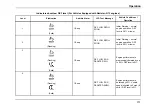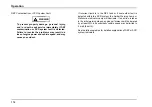
Operation
Dual tank systems are equipped with dual draw and dual return
fuel line systems to equalize the fuel temperature and level
between the dual tanks.
When refueling, be sure that both tanks are filled completely, as
both tanks cannot be filled from one side.
Fueling Precautions
Federal Motor Carrier Safety Regulations require the driver
or any employee of a motor carrier to observe the following
requirements:
WARNING
To prevent property damage, personal injury, and / or death,
do not overfill the fuel tank. An overfilled tank may leak,
causing fuel spray and fire.
The advertised capacity of
the fuel tank is the sum of the indicated capacity on the
fuel gauge and the reserve fuel in the tank, after the gauge
indicates empty.
1.
Do not fuel a motor vehicle with the engine running,
except when it is necessary to run the engine to fuel the
vehicle.
2.
Do not smoke or expose any open flame in the vicinity
of a vehicle being fueled.
3.
Do not fuel a motor vehicle unless the nozzle of the fuel
hose is continuously in contact with the intake pipe of
the fuel tank.
4.
Do not permit any other person to engage in such
activities as would be likely to result in fire or explosion.
Reserve Fuel
No extra supply of fuel for the propulsion of the vehicle or for the
operation of accessories shall be carried on any motor vehicle,
except in a properly mounted fuel tank or tanks.
Transmission
Transmission Fluid
Transmission fluid cools, lubricates and transfers hydraulic
power. Proper fluid level and condition is critical to operation of
the vehicle. If the fluid is low, the torque converter and clutches
starve for fluid and the transmission overheats. If the fluid level
is too high, the fluid may aerate, which may potentially cause
the transmission to overheat.
Periodic transmission fluid checks are recommended by every
transmission manufacturer. Refer to the transmission operators
manual for additional information and proper procedures.
NOTE: All transmission manufacturers have guidelines
for transmission fluid and filter change intervals. Driving
conditions, severity of duty cycle, and other factors
impact the service cycle for fluid and filter change
intervals. Some manufacturers recommend fluid analysis to
determine service requirements. Refer to the Transmission
Operator’s Manual for more information and proper service
procedures.
157
Summary of Contents for ProStar+
Page 4: ......
Page 24: ...Foreword 12...
Page 38: ...Model Description 26...
Page 74: ...Controls Features Declination Zone Map 62...
Page 98: ...Controls Features Center Dash Panel Wing Panel 86...
Page 118: ...Controls Features 106...
Page 243: ...Maintenance Instructions 231...
Page 286: ...Maintenance Intervals and Specifications 274...


































